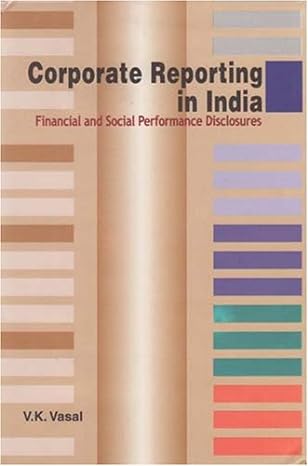Question
Exercise 1-6 A. Lang Enterprises was started when it acquired $4,000 cash from creditors and $6,000 from owners. The company immediately purchased land that cost
Exercise 1-6 A.
Lang Enterprises was started when it acquired $4,000 cash from creditors and $6,000 from owners. The company immediately purchased land that cost $9,000.
a. Record the events under an accounting equation.
b. After all events have been recorded, Lang's obligations to creditors represents what percent of total assets?
c. After all events have been recorded, Lang's stockholder's equity represents what percent of total assets?
d. Assume the debt is due. Given that Lang has $6,000 in stockholder's equity, can the company repay the creditors at this point? Why or Why not?
Exercise 1-7A Components of the Accounting Equation:
The financial condition of Greyco Inc. is expressed in the following accounting equation:
Assets = Liabilities + Common stock + Retained Earnings
$700 cash + $9200 land =$7000 + $2,000 + $1000
a. Are dividents paid to creditors or investors? Explain why.
b. How much cash is in the retained earnings account?
c. Etermine the maximum dividend GreyCo can pay?
d. If the obligation to creditors is due, can Greyco repay the loan? Why or why not?
e. Suppose the land sinks into the sea as a result of an earthquake and a resulting tsunami. The business is then liquidated. How much cash will creditors receive? How much cash will investors receive? (Assume there are no legal fees or other costs of liquidation?
Exercise 1-9A: Missing information and recording events:
As of 12-31-2013 Post Company had $156,000 cash, notes payable of $85,600, and common stock of $52,400. In 2014 Post earned $36,000 of cash revenu, paid $20,000 for cash expenses and paid $3,000 cash dividend to stockholders.
a. Determine the amount of retained earnings as of 12-31-2013.
B. Create an accounting equation and record the beginning account balances under the appropriate elements.
C. Record the revenue, expense, and dividend events under the appropriate elements of the accounting equations in question B.
D. Prove the equality of the accounting equation as of December 31, 2014.
E. identify the beginning and ending balances in the Cash and Common stock accounts. Explain why the beginning and ending balances in the Cash account are different, but the beginning and ending balances in the common stock account remain the same.
Step by Step Solution
There are 3 Steps involved in it
Step: 1

Get Instant Access to Expert-Tailored Solutions
See step-by-step solutions with expert insights and AI powered tools for academic success
Step: 2

Step: 3

Ace Your Homework with AI
Get the answers you need in no time with our AI-driven, step-by-step assistance
Get Started


